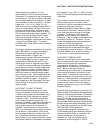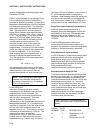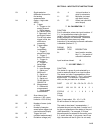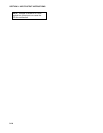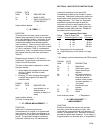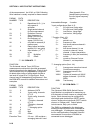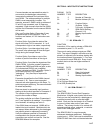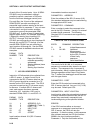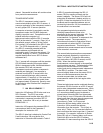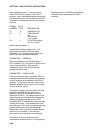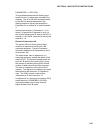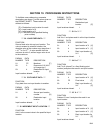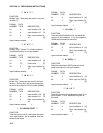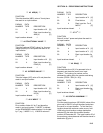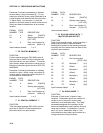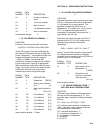SECTION 9. INPUT/OUTPUT INSTRUCTIONS
9-19
altered. Sequential locations will contain values
from previous measurements.
TRANSPARENT MODE
The SDI-12 transparent mode is used to
communicate directly with a SDI-12 sensor. A
common application of the transparent mode is
to verify proper SDI-12 sensor operation.
A computer or terminal is required to use the
transparent mode; the CR10KD (keyboard
display) cannot be used. Transparent mode is
entered while the computer is in
telecommunications with the SDI-12 recorder
CR10 (at the asterisk '*' prompt). Enter 'pX' at
the asterisk prompt, where 'p' is the Control
Port number (1-8) attached to the SDI-12 data
line. The CR10 responds with a '<' prompt.
Any SDI-12 command preceded with the
sensor address and followed with an
exclamation point '!' may then be entered. For
example, entering '0I!' at the '<' prompt would
request identification from a SDI-12 sensor
addressed at 0.
The '<' prompt will not appear until the recorder
CR10 finishes executing all program tables.
While in transparent mode, scheduled tables in
the recorder CR10 will not execute.
Transparent mode ends when a response is
received and displayed, if no response is
received from the SDI-12 sensor within the
time-out period following a valid command
(approximately 1/3 second), or if the user does
not enter a command before the mode times
out (approximately 35 seconds). Security must
be unlocked to level 2 before the Transparent
mode is used.
*** 106 SDI-12 SENSOR ***
Instruction 106 allows a CR10 to be used as a
SDI-12 sensor. The CR10 can make
measurements and transfer data using SDI-12
commands in response to another SDI-12
recorder. Instruction 106 is only in standard
PROM OSI0-1.1.
Instruction 106 supports the standard SDI-12
commands as listed in the Parameter 2
description for Instruction 105.
The SDI-12 data line is attached to Control Port
8 and Instruction 106 must be the first
instruction in Subroutine 98 located in Table 3.
A SDI-12 recorder addresses the SDI-12
sensor CR10 by sending a Break and the
sensor's address. The sensor CR10 will call
subroutine 98 whenever it detects activity on
the SDI-12 data line attached to Port 8, but if
the Break and the specified address are not
received by Instruction 106, the remainder of
the subroutine is not executed.
Two programming techniques exist for
obtaining measurement values to be
transferred by the sensor Instruction 106. The
first technique makes the requested
measurements "on demand" in response to the
recorders request. The measurement
instructions are located in Subroutine 98 and
are executed only when the SDI-12 recorder
requests measurements. This technique is
preferred when measurements are to be made
at the recorder's command.
The second technique transfers measurement
values previously obtained by instructions in
Table 1 or Table 2. Subroutine 98 contains
only Instructions 106 (SDI-12 sensor) and 95
(End). When the recorder requests
measurements, values already in the specified
input locations are used. The advantage of this
technique is that the sensor CR10 can be
making and storing measurements independent
of the SDI-12 recorder. The data is also
returned slightly faster since the sensor CR10
does not make measurements when the
recorder requests data, but rather uses
measurements made at the last regular table
execution.
These two techniques can be combined allowing
the sensor CR10 to function as a SDI-12 sensor
and to make independent measurements. While
Subroutine 98 is being executed, normal Table 1
or 2 execution scheduling may be altered or
missed since Subroutine 98 is not interrupted.
This is likely to occur if Subroutine 98 execution
takes longer than the scan interval programmed
for Table 1 or 2. It is also possible for
instructions in Table 1 or 2 to prevent
Subroutine 98 from being called in time for
Instruction 106 to receive the address
information from the recorder. This is likely to
occur only if Table 1 or 2 is executed often and
has instructions that take longer than 1/3 second
to execute. For example, Instruction 4 (Excite-
Delay-SE) with a 1/2 second delay could cause
Subroutine 98 to miss the SDI-12 address
information if it were executing when the SDI-12



